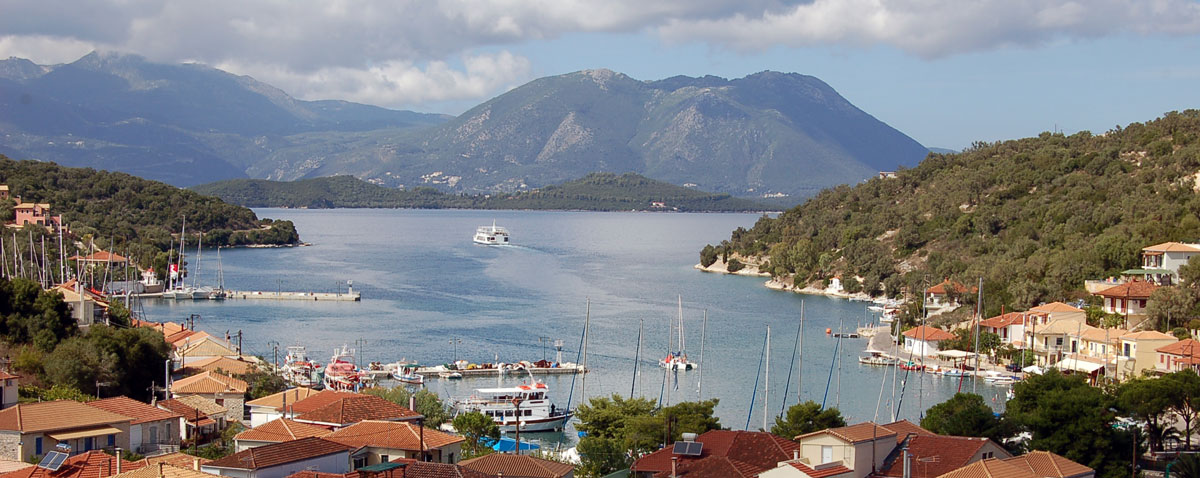
Meganisi is the largest island of the Prigipónisa cluster of islands (as its name suggests), with an area of 20 square kilometers, and is located 4 miles southeast of Lefkada. In the municipality of Meganisi, apart from the homonymous island, belongs the well-known islet of Scorpios as well as the islets of Skorpidi, Sparta, Madouri, Heloni and Tsokari which are also called Televoid islands.
People lived in Meganisi ever since the Neolithic era. The first name of the island was Táfos (Tomb), from the son of the daughter of Lelegas of Lefkada and Poseidon. Homer mentions that Anchilaus, a prudent man and a heartfelt friend of Odysseus and later his son Mentis (in whose form Athena appeared in Telemachus) reigned in Táfos, the inhabitants of which were excellent merchants (the only ones who traded in iron), worthy and brave sailors.
During the Bronze Age, the Tafian (Televoid) pirates had Meganisi as a springboard and had generally dominated the wider area. Some Latin writers have argued that the ancient island of Capria (modern-day Capri, Italy) was a Tafian colony.
Meganisi, like all of Lefkada, first experienced the Frankish occupation after the fall of Constantinople and then fell to the Turks. But it was soon occupied by the Venetians, then fell to the French again and, a year later, to the Russo-Turks. Meganisi has always been the refuge of the renowned Greek Kléftes and Armatoli (guerilla freedom fighters). Finally it was conquered by the English to be given to the Greeks for good in 1864, together with the Ionian Islands.
Access to the island is by boat from Nydri, Lefkada.
In Meganisi the shapes of its shores form deep coves, especially on its northern side, which resemble “fjords” between steep cliffs and sandy beaches. The landscape is full of all kinds of plants, arbutus, laurels, olives, prunes and sea pines that grow between the rocks and reach the sea.
The windmills that you will see in various places are private, in fact one of them is considered the best preserved in the Ionian, as its mechanism is intact and operated until 1949. At Vigla various relics have been found that show there was communication between Meganisi and Kalamos islands since antiquity.
In the southwestern part of the island it is worth seeing Chálasma, the Cave of Papanikolis, a rocky pit in the south which was used as a refuge and a base by the historic submarine “Papanikolis” in World War II. The cave has a length of 120 meters, and an entrance width that starts from 60 meters and reaches 23 meters inside, while its depth is around thirty meters. The cave ends on a small sandy beach. It is worth seeing two other caves, except Papanikolis, which are also located at the southwestern tip of the island, Giovanis and Daimonas.

Vathý
Vathy is located at the heart of an all-round protected bay, a natural harbour. It is a popular anchorage, where fishing boats can be repaired or yachts that dock in the summer choose to moor in its modern marina.

Spartohóri
It is a beautiful traditional settlement with stone houses and picturesque labyrinthine alleys, which stands at the top of the hill and overlooks the Caves. The village has a square, with panoramic views to the west coast of Meganisi but also to Scorpios islet and the east coast of Lefkada.
From a path drowned in the green, in which hides the Cave of the Cyclops is to be found, one descends to Spília, its port.
The Church of Agios Ioannis Prodromos is built on a pebble beach on the west side of Meganisi, next to the sea strait that separates the island from Lefkada. Tradition has it that the monastery of Agios Ioannis Prodromos was founded before the fifteenth century and was destroyed by pirates who threw the image of the Saint into the sea. The icon was pulled by a fisherman into his nets. In the middle of the 19th century, Saint Joachim of Ithaca sent a woman of deep faith to rebuild the temple with fundraisers and with the help of other believers. Every year on June 23 and 24 there is a big festival in honor of the Saint.
Spília
It is one of the three ports of Meganisi, along with Atherinos and Vathi.
Its beach, near the pier, is an organized pebble beach with clear waters. It is shaded by pines and cypresses and is usually not crowded even during the high season.
The cave of the Cyclops, in the bay of Kalopoulos, lies above the harbour and at a height of 50m. from the surface of the sea. It could be the cave of the Cyclops from the Odyssey, but of course there are two more “candidate” caves that fit Homer’s descriptions. The cave has been known since ancient times, and is said to have been used by Cyclops Polyphemus’ flock.




